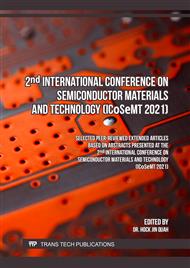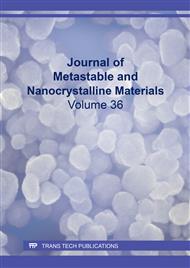[1]
J.G Liu, T.S Zhao, R. Chen R, C.W Wong. The effect of methanol concentration on the performance of a passive DMFC. Electrochem Commun 7 (2005) 288–94.
Google Scholar
[2]
Z.A.C Ramli, S.K Kamarudin. Platinum-Based Catalysts on Various Carbon Supports and Conducting Polymers for Direct Methanol Fuel Cell Applications: A Review. Nanoscale Res Lett 13 (2018) 410.
DOI: 10.1186/s11671-018-2799-4
Google Scholar
[3]
J.N Tiwari, R.N Tiwari, G. Singh, K.S Kim. Recent progress in the development of anode and cathode catalysts for direct methanol fuel cells. Nano Energy 2 (2013) 553–78.
DOI: 10.1016/j.nanoen.2013.06.009
Google Scholar
[4]
S.S Mahapatra, J. Datta. Characterization of Pt-Pd/C Electrocatalyst for Methanol Oxidation in Alkaline Medium. Int J Electrochem 2011 (2011) 563495.
DOI: 10.4061/2011/563495
Google Scholar
[5]
J. Wu, S. Shan, H. Cronk, F. Chang, H. Kareem, Y. Zhao et al. Understanding Composition-Dependent Synergy of PtPd Alloy Nanoparticles in Electrocatalytic Oxygen Reduction Reaction. J Phys Chem C 121 (2017) 14128–36.
DOI: 10.1021/acs.jpcc.7b03043
Google Scholar
[6]
S. Yin, Y. Ding. Bimetallic PtAu electrocatalysts for the oxygen reduction reaction: challenges and opportunities. Dalt Trans 49 (2020) 4189–99.
DOI: 10.1039/d0dt00205d
Google Scholar
[7]
Z. Li, Y Li, C. He, P.K Shen. Bimetallic PtAg alloyed nanoparticles and 3-D mesoporous graphene nanosheet hybrid architectures for advanced oxygen reduction reaction electrocatalysts. J Mater Chem A 5 (2017) 23158–69.
DOI: 10.1039/c7ta07525a
Google Scholar
[8]
J. Jeevanandam, A. Barhoum, Y.S Chan, A. Dufresne, M.K Danquah. Review on nanoparticles and nanostructured materials: history, sources, toxicity and regulations. Beilstein J Nanotechnol 9 (2018) 1050–74.
DOI: 10.3762/bjnano.9.98
Google Scholar
[9]
C. Li, Y. Xu, Y. Li, H. Yu, S. Yin, H. Xue et al. Engineering porosity into trimetallic PtPdNi nanospheres for enhanced electrocatalytic oxygen reduction activity. Green Energy Environ 3 (2018) 352–9.
DOI: 10.1016/j.gee.2018.07.004
Google Scholar
[10]
K. H Huynh, X.H Pham, J. Kim, S.H Lee, H. Chang, W.Y Rho, et al. Synthesis, Properties, and Biological Applications of Metallic Alloy Nanoparticles. Int J Mol Sci 21 (2020) 5174.
DOI: 10.3390/ijms21145174
Google Scholar
[11]
A. Morozan, A Dumitru, C. Mirea, I. Stamatin, F. Nastase, A. Andronie, et al. Synthesis and Characterization of Carbon Supported Pd and PtPd Catalysts for DMFCs BT - Functionalized Nanoscale Materials, Devices and Systems, Springer Netherlands, Dordrecht; 2008, p.445–8.
DOI: 10.1007/978-1-4020-8903-9_46
Google Scholar
[12]
K. Ranoszek-Soliwoda, E. Tomaszewska, E. Socha, P. Krzyczmonik, A. Ignaczak, P. Orlowski, et al. The role of tannic acid and sodium citrate in the synthesis of silver nanoparticles. J Nanopart Res 19 (2017) 273.
DOI: 10.1007/s11051-017-3973-9
Google Scholar
[13]
T. Xia, H. Shen, G. Chang, Y. Zhang, H. Shu, M. Oyama, et al. Facile and Rapid Synthesis of Ultrafine PtPd Bimetallic Nanoparticles and Their High Performance toward Methanol Electrooxidation. J Nanomater 2014 (2014) 496249.
DOI: 10.1155/2014/496249
Google Scholar
[14]
S. Ghosh, B.R Jagirdar. Synthesis and Mechanism of Formation of Metal Nanosponges and their Catalytic and Hydrogen Sorption Properties. Chemistry Select 3 (2018) 7184–94.
DOI: 10.1002/slct.201801562
Google Scholar
[15]
H. Wang, W. Wang, Y. Zhao, Z. Xu, L. Chen, L. Zhao L, et al. Superior adsorption of 3D nanoporous architectures for Ni (II) ions adsorption using polyvinyl alcohol as cross-linking agent and adsorption conveyor. RSC Adv 8 (2018) 7899–903.
DOI: 10.1039/c8ra00113h
Google Scholar
[16]
Z. Jiadong, S. Yanyan, Z. Sun. Bimetallic nanoporous Pd–Ag prepared by dealloying with polyvinylpyrrolidone and their electrocatalytic properties. Nanotechnology 29 (2018) 485401.
DOI: 10.1088/1361-6528/aae05e
Google Scholar
[17]
S. S Mahapatra and J. Datta. Characterization of Pt-Pd/C Electrocatalyst for Methanol Oxidation in Alkaline Medium. Int. J. Electrochemistry 2011 (2011)
DOI: 10.4061/2011/563495
Google Scholar
[18]
A.V. Tripkovic, K. Dj. Popovic, J.D. Lovic, V.M. Jananovic, and A. Kowal. Methanol oxidation at platinum electrodes in alkaline solution: comparison between supported catalysts and model systems. Journal of Electroanalytical Chemistry, 572 (2004) 119–128, 2004.
DOI: 10.1016/j.jelechem.2004.06.007
Google Scholar



